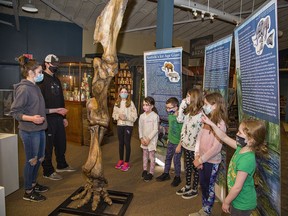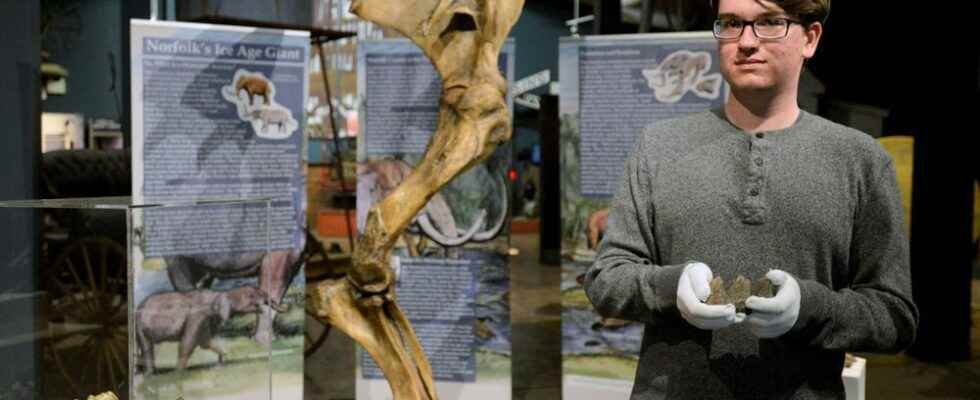

It stood over three meters tall, with curved tusks nearly as long.
Lumbering past lakes formed by retreating glaciers, it shared sprawling forests with deer as big as moose and beavers the size of black bears.
It is one of the largest mastodons ever discovered in Ontario, and 100,000 years ago it called Norfolk County home.
The Marburg Mastodon got its name from the village near Port Dover where in 1897, a farmer draining a field unearthed the prehistoric creature’s giant skull.
“It turned out to be the remains of an incredibly large mastodon — possibly the biggest that’s ever been found in Ontario,” said Sam Welsh, a high school student whose exhibit about the mastodon, called “Norfolk’s Ice Age Giant,” was recently unveiled at the Waterford Heritage and Agricultural Museum (WHAM).
The farmer, Charles Challand of Marburg, was started to see huge tusks emerge from what was later determined to have been an ice age peat bog, a low-oxygen environment perfect for preserving fossils.
One of the tusks was broken — perhaps during a sparring match with another mastodon, Welsh theorized — and part of the gigantic skull quickly crumbled in the open air.
But the front section of the skull, along with pieces of backbone and two-metre-long ribs, were excavated intact.
The prehistoric remains caused a stir at the Port Dover fair before being whisked away to an Ottawa museum for study, not returning home until Canada’s centennial 70 years later to enthrall visitors at the Eva Brook Donly Museum in Simcoe.
Today, said WHAM curator James Christison, most of the fossils are tucked away in storage at the Royal Ontario Museum in Toronto.
But not all.
Inside two glass cases at the Waterford museum can be found several of the giant herbivore’s spiky teeth and fragments of its prodigious jawbone, all on display for the first time in over half a century.
The exhibit’s eye-catching centrepiece, a full-length mastodon leg fossil complete with bony toes, is a replica the museum had made for the Canada 150 celebrations in 2017.
Though well known locally, the Marburg Mastodon had never been given the full exhibit treatment until Welsh came to the museum last November on a co-op placement through Delhi District Secondary School. It wasn’t long before Christison told him to stop typing up cemetery records and get busy bringing the mastodon’s story to life.
“I’ve been interested in prehistoric animals ever since I was really little,” said Welsh, 18.
“The ice age is a really amazing time. It’s fairly recent compared to most of prehistory, so you actually get most of the same animals you find now, but alongside these giant elephants and sloths roughly the size of bears. You get all sorts of crazy stuff that actually existed.”
Mastodons are shorter and stockier than woolly mammoths, for which they are often confused. The elephantine creatures once traveled the full length of the Americas, from modern-day Alaska to South America. But fossilized mastodon remains in present-day Ontario are rare, as melting glaciers washed them southward.
“It’s the only one that’s actually been found in Norfolk,” Welsh said of the Marburg Mastodon, who likely weighed in at around six tons.
“He probably would have spent most of his time wandering through conifer forests, eating trees,” Welsh said.
Along with researching the exhibit’s written content, Welsh painted backdrops for three panels that depict ice age scenes in living colour.
“I did a lot of sketches of mastodons and elephants to try and get the anatomy down, and then planned it out,” said Welsh, who “dabbles” in paleo-art as a hobby.
“It’s a bit difficult, because you’re working with animals often known from very fragmentary skeletons and trying to figure out what they looked like in real life,” he said.
Welsh finished the watercolor paintings over Christmas break, showing his artwork to a gobsmacked Christison in the new year.
“I was floored to have a high school student produce something like this with very little instruction,” Christison said. “Sam was able to accomplish an incredible amount in the short time we had him.”
The curator especially appreciated Welsh’s attention to detail, such as giving one of the mastodons a broken tusk like the Marburg fossil and including a Canada goose alongside the prehistoric beasts to give viewers “a modern-day perspective.”
“Norfolk’s Ice Age Giant” is on at WHAM until the end of June, and Welsh got his first look at the completed exhibit during a recent visit.
“It’s pretty amazing,” he said. “I did not expect when I signed up to do this that I would end up creating an entire exhibit.”
JP Antonacci is a Local Journalism Initiative reporter based at the Hamilton Spectator. The initiative is funded by the Government of Canada.
